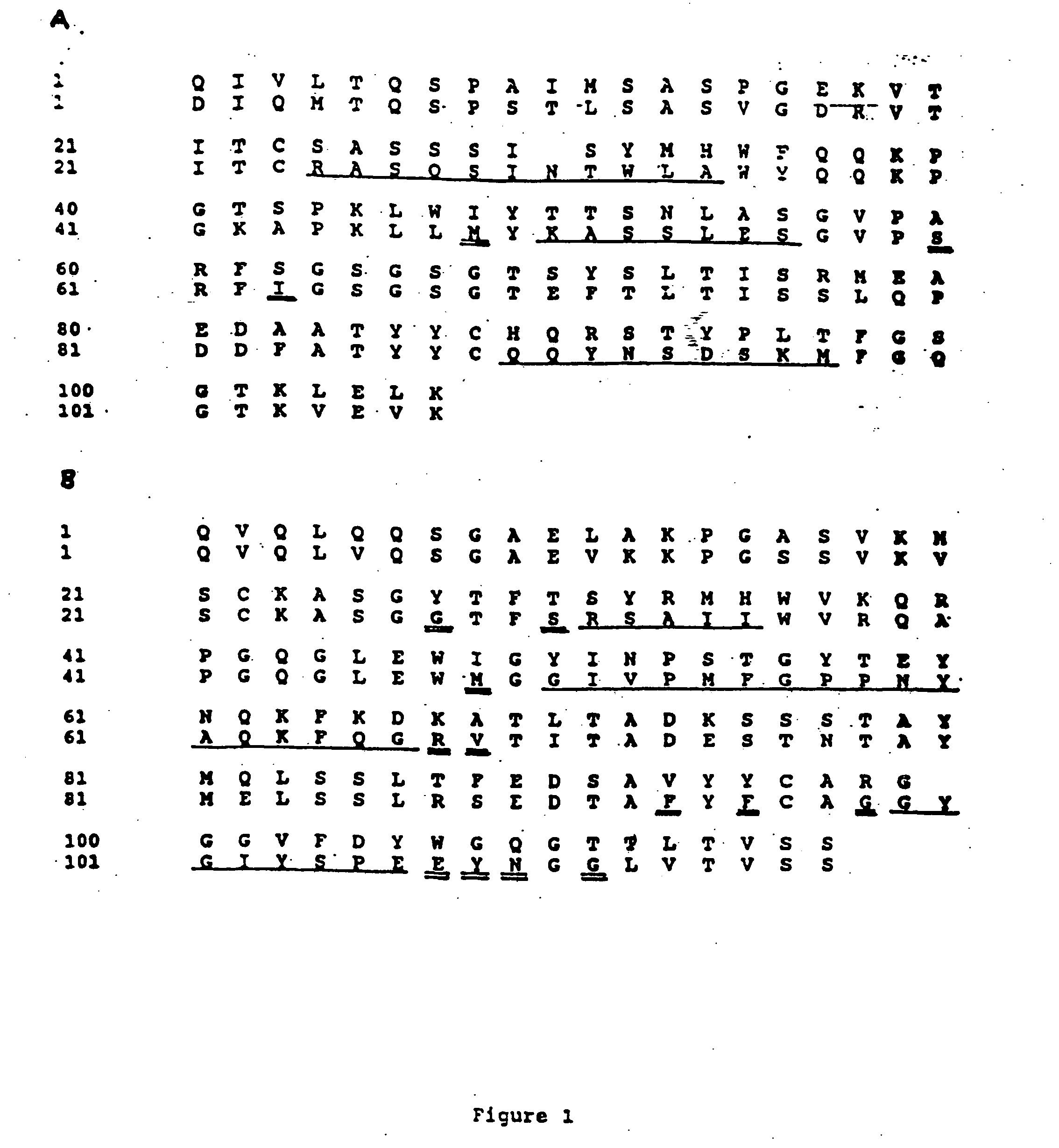Humanized immunoglobulins
a technology of immunoglobulins and humanized cells, which is applied in the field of humanized immunoglobulins, can solve the problems of lack of other important immunoglobulin functional characteristics when used in humans, the use of non-human monoclonal antibodies, mouse monoclonal antibodies, etc., and achieves the effect of maximizing the likelihood of humanized immunoglobulin production, improving binding affinity, and easy production
- Summary
- Abstract
- Description
- Claims
- Application Information
AI Technical Summary
Benefits of technology
Problems solved by technology
Method used
Image
Examples
example 1
Humanized Anti-Tac Antibody
Design of Genes for Humanized Anti-Tac Light and Heavy Chains
[0124]The sequence of the human antibody Eu (Sequences of Proteins of Immunological Interest, E. Kabat et al., U.S. Dept. of Health and Human Services, 1983) was used to provide the framework of the humanized antibody, because the amino acid sequence of the heavy chain variable region of anti-Tac is more homologous to the heavy chain of this antibody than to any other complete heavy chain variable region sequence in the National Biomedical Foundation Protein Identification Resource.
[0125]To select the sequence of the humanized heavy chain, the anti-Tac heavy chain sequence (FIG. 1; see, commonly assigned U.S. Ser. Nos. 186,862 and 223,037, which are incorporated herein by reference) was aligned with the sequence of the Eu heavy chain (FIG. 1B). At each position, the Eu amino acid was selected for the humanized sequence, unless that position fell in any one of four categories defined above, in whi...
example 2
A Second Humanized Anti-Tac Antibody
Higher Level Expression of the Humanized Anti-Tac Antibody
[0151]Three new plasmid vectors were prepared for expression of the humanized antibodies. The plasmid pVg1 (FIG. 9A) contains a human cytomegalovirus IE1 promoter and enhancer (Boshart et al., Cell 41, 521 (1985), which is incorporated herein by reference), the human genomic Cγ1 segment including part of the preceding intron, and the hygromycin gene (Blochlinger et al., Mol. Cell. Biol. 4, 2929 (1984), which is incorporated herein by reference) for selection. The plasmid-pVk (FIG. 9B) is similar to pVg1 but contains the human genomic Cκ segment and the gpt gene. The plasmid pVg1-dhfr was constructed similarly to pVg1 but contains a dihydrofolate reductase (dhfr) gene (Simonsen et al., Proc. Natl. Acad. Sci. USA 80, 2495 (1984), which is incorporated herein by reference) in place of the hygromycin gene.
[0152]Xba I fragments containing the humanized anti-Tac light chain and heavy chain variab...
example 3
Construction of 5 Other Humanized Antibodies
[0158]Cloning of Heavy and Light Chain cDNAs
[0159]Five other humanized antibodies were designed and produced using the principles and categories disclosed herein. The antibodies are Fd79 and Fd138-80 which respectively bind to the gB and gD glycoproteins of herpes simplex virus (Metcalf et al., Intervirology 29, 39 (1988)), M195 (Tanimoto et al., Leukemia 3, 339 (1989)) which binds to the CD33 antigen, mik-β1 (Tusdo et al., Proc. Natl. Acad. Sci. USA 86, 1982 (1989)) which binds to the p75 chain of the IL-2 receptor, and CMV5 which binds to the gH glycoprotein of cytomegalovirus.
[0160]cDNAs for the heavy chain and light chain variable domain genes of each antibody were cloned using anchored polymerase chain reactions (Loh et al., Science 243, 219 (1989)), using 3′ primers that hybridized to the constant regions and contained HindIII sites, and 5′ primers that hybridized to the dG tails and contained EcoRI sites (Scheme shown in FIG. 14). T...
PUM
| Property | Measurement | Unit |
|---|---|---|
| Angle | aaaaa | aaaaa |
| Angle | aaaaa | aaaaa |
| Angle | aaaaa | aaaaa |
Abstract
Description
Claims
Application Information
 Login to View More
Login to View More - R&D
- Intellectual Property
- Life Sciences
- Materials
- Tech Scout
- Unparalleled Data Quality
- Higher Quality Content
- 60% Fewer Hallucinations
Browse by: Latest US Patents, China's latest patents, Technical Efficacy Thesaurus, Application Domain, Technology Topic, Popular Technical Reports.
© 2025 PatSnap. All rights reserved.Legal|Privacy policy|Modern Slavery Act Transparency Statement|Sitemap|About US| Contact US: help@patsnap.com



